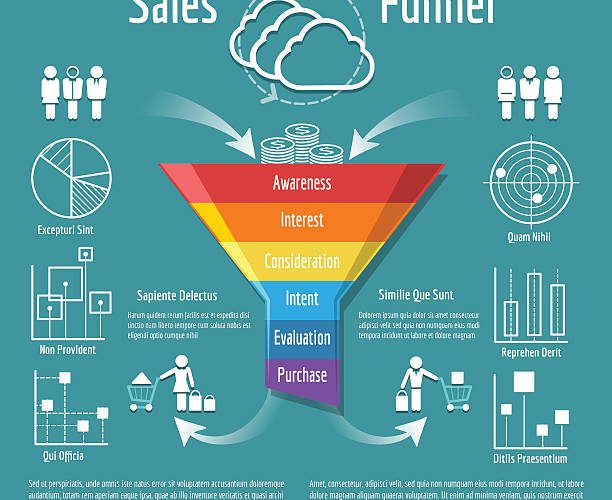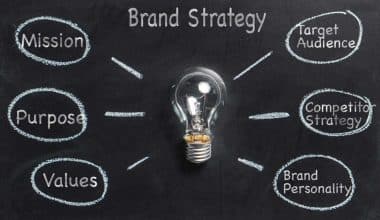Have you ever considered what your customers go through before deciding to buy from you? The journey, which is mapped out by a sales funnel, describes all of your clients’ interactions with you before they’re ready to buy. To build a successful sales plan, your sales funnel must be top-notch.
The basic goal of your sales funnel is to move clients from one stage to the next until they’re ready to buy.
As a novice to business, you may regularly find yourself in a creative state. Because you have lofty ideas and other techniques, you’re fired up and motivated to get a jump start on your plans.
Unfortunately, having a great idea and a strong desire to start a company isn’t enough to make it a success. An entrepreneur must master the tricks of the trade to avoid the dangers of a business failure.
In the business world, the sales funnel is a key concept. If you’re unfamiliar with the word, it refers to the process of generating leads and completing sales.
In this article, we have covered everything you need to know about sales funnels, including what they are, how to design one, and what material you’ll need for each phase.
What is a Sales Funnel?
A sales funnel is a model that depicts the route from a prospect’s client initial contact with you to their final purchase. It aids your sales team in determining where they need to follow up or adjust the sales process due to funnel dropoff.
A sales funnel is a marketing concept that depicts the path a consumer takes when purchasing any kind. Because a high number of potential consumers may start at the top of the sales process, the model uses a funnel as an example.
Even so, just a small percentage of these people make a purchase. Depending on a company’s sales model, a sales funnel might include numerous sales, which are commonly referred to as the top, middle, and bottom of the funnel.
As prospects progress through the funnel, they demonstrate a greater commitment to the purchase goal. This model is used by most organizations, whether online or offline, to drive their B2C marketing activities in each stage.
Typically, the marketing funnel focuses on introducing a brand to a variety of audiences. Its purpose is to attract leads who can quickly convert to buyers. They join the sales funnel after such prospects are discovered and show interest in the product or service. The prospect has now evolved into a sales prospect.
The sales funnel is the process of moving a sales prospect from the takeover stage (marketing) through conversion. The funnel is the narrowest part of the marketing funnel’s cone form.
B2B Sales Funnel defination
Three processes are critical for a complete understanding of a B2B sales funnel:
- Buying: Looking for a solution to an issue (pain point)
- Selling: Entails locating and engaging with consumers who are experiencing a certain problem in order to supply a solution.
- Marketing: Studying problems and individuals who have them, educating potential customers, and assisting sellers are all examples of marketing.
The B2B sales funnel is where these three processes collide and interact. It is up to a certain organization to decide how this junction should be set up.
Obviously, you don’t have complete control over the purchasing process; you can’t force someone to buy your goods.
A controllable selling process and effective marketing methods, on the other hand, can have an impact.
As a business owner, You need a sales funnel to attract and convert visitors into customers, whether you have a physical product or an internet firm. The primary purpose of your sales funnel is to guide customers through the various stages of the sales process until they are ready to purchase your goods or services. Learn more: What is B2B Sales? 15 Best Strategies for B2B Sales Lead
The four basic stages of the Sales Funnel are:
- Awareness
- Relationship Stage
- Sales Stage
- Upsell Stage
Before we go into these stages, let’s talk about why we need a sales funnel in the first place.
Why sales funnel?
- It helps you generate more sales
- Enables you pick a marketing strategy.
- It helps you improve on the ways you can grow your business
- The sales funnel helps you know how to relate to your customers
- The sales funnel gives you an advantage over other beginner business owners.
>. It helps you generate more sales
You’ll lead more potential customers to the Action section if you choose a fantastic marketing approach and know-how to relate to your customers better. In fact, mastering the sales funnel will help you earn more sales in the long term. The key to mastering the sales funnel is to discover how to guide them systematically toward your desired goal.
>.Enables you pick a marketing strategy
Do you frequently find yourself broke as a result of marketing techniques that produce little to no results? This is why you need to grasp the sales funnel so you can figure out which marketing tools or company model you’ll need to succeed as an entrepreneur.
Some marketers prefer to concentrate their efforts on customers who have already reached the Decision stage of the sales funnel. This makes it easy for them to get clients to click on the “Action” button. Review sites and speciality retail locations are examples of this.
>. It helps you improve on the ways you can grow your business
There is no such thing as a perfect business model. Many overnight achievements, in reality, are not truly overnight. You will have more feedback on what techniques will help you expand your sales if you understand the sales funnel.
Perhaps you discovered that due to your pricing, potential clients at the Decision section choose to buy another product. You may simply change these by identifying the bottlenecks that prevent customers from achieving their intended outcomes.
>. The sales funnel helps you know how to relate to your customers
Do you realize that businesses have their own language? The way we define our products, provide content, and communicate with our customers can all have an impact on how far they progress down the sales funnel. Once you’ve identified a potential customer’s sales funnel section, you can quickly adjust the tone of your writing, create well-directed content, or make appealing offers to better relate to their needs.
>.The sales funnel gives you an advantage over other beginner business owners.
The lack of direction that some businesses face is a typical issue. They may have brilliant ideas, but they are unable to put them into action since no tried and true sales procedures are used. You can obtain a competitive advantage over other businesses in your niche if you understand how the sales funnel works. Also, read: What is Sales Forecasting? Methods and Real-world Examples
Sales funnel examples
A sales funnel for a marketing entrepreneur offering online courses would look something like this:
- On Facebook, a user sees an ad offering SEO advice with the following call-to-action: My whole SEO guide is available for download.
- The user is taken to a landing page where she can download the guide and sign up to receive emails from the entrepreneur.
- The next day, she receives a newsletter with a link to the available courses.
- The user enrols in one of the classes.
- She continues to get newsletters with course fee discounts and re-enrols.
All of these steps in the buyer’s journey will be tracked by the entrepreneur’s sales funnel software, allowing her to know exactly where consumers are dropping off and where they are converting.
Sales funnel stages
Here are sale funnel stages you need for your business:
- Awareness
- Relationship Stage
- Sales Stage
- Upsell Stage
>. Awareness Stage
The purpose of the Awareness Stage is to let people aware that you exist. “What can I do to make people aware of my business?” you might wonder.
There are a variety of strategies to reach out to your target audience and raise brand awareness.
Marketing with Content
One strategy to grow an audience and raise brand awareness is through content marketing. Writing articles may increase traffic to your website through SEO and social media while also establishing you as a subject matter authority.
Video
Another method that can be used to raise awareness is video. People can get a better sense of who you are as a person by watching videos of you. Videos can also be used to show how a product (or service) works or to share other ideas.
Advertisements that are paid for
Advertising is a terrific strategy to immediately reach your target demographic. Paid advertisements frequently allow you to target people based on their likes or demographics.
Referrals and word-of-mouth
If your products or services and content are good, word of mouth and referrals will begin to develop recognition for your company.
While it’s good to obtain consumers through referrals, don’t count on it. Create a true marketing system that generates predictable money and results instead.
>.Relationship Stage
In the Relationship Stage, once individuals are aware of your brand, you want to continue to build a relationship with them. In this stage, consider how you can establish trust and authority so that people are willing to buy from you.
Consider which communication channels will best enable you to communicate with your target audience.
Because email marketing is relatively inexpensive, it is a popular choice among online marketers. You can keep communicating with someone who joins your email list by sending them emails.
You may even utilize re-targeting to show advertising to people who have already visited your site, allowing you to maintain brand awareness among those visitors.
Social media, seminars, and even sponsored movies are examples of additional channels.
During the Relationship Stage, you must also decide what buying beliefs you must instil in your customer before they would purchase.
A belief system is made up of a person’s biases and beliefs about your product or service.
Determine which purchasing beliefs are required. Then, during the Relationship Stage, add them into your sales funnel. Educate your prospects so that when they reach the Sales Stage, they are ready to buy.
>. Sales Stage
Send your prospects to the Sales Stage once they’ve completed the Relationship Stage so you can close the deal. At this point, think about the best strategy to encourage folks to pay.
Selling should be simple if your Relationship Stage is well-designed. Your customer will be eager to purchase your goods or services.
However, having a strong Sales Stage can help you increase your performance.
The Sales Stage for a high-end conference can have a landing page with a video and a roster of highlighted speakers.
It could also include other advantages of attending, such as the opportunity to network with other successful people.
Using urgency or scarcity to drive consumers to buy is another technique to boost sales performance. If you performed a good job of creating trust and authority in the Relationship Stage, or if you employ a Relationship Funnel for your business instead of a sales funnel, scarcity is optional.
To entice people to buy, don’t create a false sense of scarcity. Customers can sense it, and it makes them wary of you.
>.Upsell Stage
Finally, the Upsell Stage is when firms can make more money by selling their client’s other related products or services. McDonald’s became a multibillion-dollar corporation by merely asking consumers after they purchased a burger, “Would you like fries with that?”
Upselling can improve the customer experience in addition to increasing income for your company. Some folks who purchase a ticket to your live conference may be willing to pay more to speak with you one-on-one.
Consider what other products or services your consumers might be interested in when creating your upsells.
Is it possible to upsell them on a more expensive product or service that will benefit them even more? Can you cross-sell them on a similar product or service that they might like?
How to create a sales funnel
There are a variety of ways to build a sales funnel, and each business and industry has its own set of sales funnels. To make a sales funnel for your company, follow these steps:
>. Create a landing page
The landing page is frequently a prospect’s initial introduction to your company and its products and services. Users will get at your landing page in a variety of methods, including clicking on a social media ad or link, downloading an e-book, or signing up for a webinar.
Your landing page should clearly state who you are and what makes your product or service distinctive. Because the landing page may be your last chance to impress potential customers, the copy should be solid and intriguing. It should also contain a mechanism to collect the prospect’s contact information so you can keep in touch with them.
>. Offer something valuable
You must supply something in return for a prospect to provide their email address. You may, for example, provide a free e-book or whitepaper with important and instructive information.
>.Nurture the prospect
Nurture the prospect with information that educates them about your product or service now that they’ve shown enough interest to offer their email address. You should communicate with them on a regular basis (once or twice a week), but not so frequently that they become bored or turned off by the volume of information. Ascertain that the content meets their primary requirements and overcomes any potential concerns.
>. Complete the transaction
To complete the transaction, make your best offer – one that is impossible for the prospect to overlook or reject. You may offer a product demonstration, a free trial, or a unique discount coupon, for example.
>. Keep the process going
The prospect has either become a customer or decided not to make the transaction at this point in the sales funnel. In either situation, you should keep communicating and cultivating relationships.
If the prospect becomes a customer, keep the relationship going by teaching them about your products or services, engaging them on a frequent basis to establish loyalty, and providing excellent service to keep them as loyal customers. If the prospect does not make a purchase, send them emails on a regular basis. Continue to use different email nurturing series to convert them into customers.
>. Optimize your sales funnel
Your work is never done once you’ve developed a sales funnel. You should always be looking for methods to improve and optimize your sales funnel, as well as figuring out where you’re losing leads. Concentrate on the locations where prospects pass through the sales funnel from one stage to the next.
Start at the top of the funnel and work your way down. Examine the performance of each item of content. Is your initial content catching enough leads for you? The purpose of your content is to entice prospects to take action by clicking on the call to action (CTA). Rework that aspect or try something new if they aren’t doing so, or if one piece of content is getting fewer clicks on the CTA.
Examine the landing page. The content (e.g., blog post, Facebook ad) that brought the prospect to your landing page should be mirrored in your offer and CTA. Do prospects put their trust in you when it comes to their contact information? To figure out what works and what doesn’t, test every aspect of your landing page (for example, the headline, photos, body copy, and CTA).
In the action stage of your sales funnel, test each offer. Compare the outcomes of several offers (e.g., free shipping versus discounts). How many sales do your email nurturing campaigns and other marketing activities generate? Also, If one offer performs significantly better than another, concentrate on closing prospects with that offer and see if you can improve.
Keep track of how long your customers stay with you. Determine how frequently customers return to your store to buy your goods or services. Do clients return frequently, and do they purchase additional goods or services? Keep note of how often they recommend your company to others.
Top sales funnel software
Here are the best sales funnel software for your business
- GetResponse – All-in-one machine
- Kartra – Great for agencies
- ClickFunnels – Unlimited contacts
- Wishpond – Good looking templates
- Thrive Suite – Good value for money
- Keap – Plenty of options
- Leadpages – Collect unlimited leads
- Landingi – Great looking landing pages
- Instapage – Sophisticated A/B testing
Also read: ONLINE CRM: Best Small Business Online System Software in 2023 (Free & Paid)
What Is the Difference Between the Sales Funnel and the Marketing Funnel?
At the end of the marketing funnel, the sales funnel begins. The marketing funnel helps prospects become more interested in your brand by guiding them from their first interaction to a point where they want to learn more about your products or services. The marketing funnel can also assist with lead generation and nurturing. The prospect exits the marketing funnel and enters the sales funnel after they are aware of your brand.
What Is the Difference Between a Sales Pipeline and a Sales Funnel?
A sales pipeline is a set of actions for converting a lead into a paying customer. Each stage is completed by the prospect until they make a purchase and become a client. The steps of the sales pipeline and sales funnel are the same, however, they are depicted differently. The sales pipeline illustrates the value, quantity, and stage of various open transactions at any given time, whereas the sales funnel explains the overall number of deals and what proportion of those deals have progressed through each stage of the sales process.
How to Defiend Sales Funnel Manager ?
A sales funnel manager is responsible for supervising the customer journey from awareness to action, as well as discovering and addressing any sales funnel leaks. However, CRM software automates and streamlines the process of managing the sales funnel, including qualifying leads, tracking prospects’ behaviour at each stage of the buyer journey, and automatically following up when the time is right.
When to use Sales Funnel Software
If you’re just getting started, sales funnel software can be a good fit because it keeps your upfront spending to a minimum. Also, you won’t need to hire a web developer or sign up for a dozen tools, but you will want to be sure that the program you choose offers all you require.
Conclusion
Sales funnels are quite effective. They assist firms and entrepreneurs in interacting with potential clients and create strong relationships. It demonstrates how a company may focus on the consumer rather than the bottom line.
- How to Build an Email Marketing List From Scratch in 10 Steps
- Top Email Marketing Platforms: 15+ Best Picks For 2023 (Updated!!)
- Product Life Cycle Stages Explained With Real-world Examples
- Free Email Marketing Software: Best 15+Picks For E-Commerce.
- Sales Process: Steps & Stages to Close Sales Efficiently in 2023!!!






